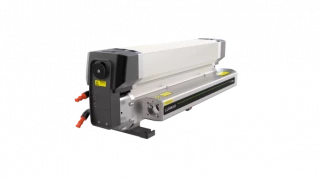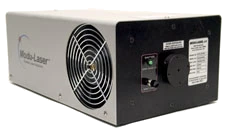Gas Lasers
Frequently Asked Questions
A gas laser is a type of laser that uses a gas as the active medium to produce a coherent beam of light. The gas is typically excited by an electrical discharge to create a population inversion that results in stimulated emission of photons.
A variety of gases can be used as the active medium in gas lasers, including helium-neon (HeNe), argon-ion (Ar-ion), carbon dioxide (CO2), and nitrogen (N2). Each gas has different properties and is used in different types of gas lasers.
The lifespan of a gas laser depends on several factors, including the type of gas used, the quality of the components, and the operating conditions. Some gas lasers can operate for tens of thousands of hours, while others may need to be replaced after only a few hundred hours of use.
Gas lasers can be safe to use if they are operated properly and appropriate safety measures are taken. However, they can be hazardous if not used correctly. It is important to follow safety guidelines and receive proper training before operating a gas laser.
The primary factors that determine the output wavelength of a gas laser include the gas used, the resonant cavity, and the power supply. These can be controlled to achieve specific wavelengths through a combination of gas composition, pressure, and temperature, as well as the use of specific cavity mirrors and optics. In addition, some gas lasers can be tuned to adjust the output wavelength over a small range by changing the cavity length or using an external tuning element, such as an etalon or grating.
Gas discharge and excitation in gas lasers cause electrons to collide with gas atoms or molecules, which then become excited and reach a higher energy level. When these excited atoms or molecules return to their ground state, they emit photons at specific wavelengths, resulting in laser light emission. The efficiency of this process can be affected by various factors such as gas pressure, gas composition, temperature, and the design of the laser cavity.
Gas lasers can be optimized to achieve high power output and high beam quality by selecting a gas mixture that is stable, homogeneous, and has the appropriate energy levels for the desired wavelength range. The gas mixture should be selected based on the specific requirements of the laser system. For example, a helium-neon (He-Ne) laser is commonly used in alignment applications due to its high beam quality, while a carbon dioxide (CO2) laser is commonly used in industrial cutting applications due to its high power output. The design of the optical resonator is another important factor in optimizing the laser's performance. The optical resonator should be designed to minimize the loss of the laser light and maximize the output power. This can be achieved by selecting appropriate mirror coatings, designing the cavity length to match the desired wavelength, and minimizing the diffraction losses that can occur due to the beam's divergence. The design of the optical resonator can also impact the beam quality, as the beam can become distorted if the cavity is not optimized properly. The cooling system is also critical to achieving high power output and high beam quality in gas lasers. The cooling system should be designed to efficiently dissipate the heat generated during operation and maintain a stable operating temperature. The cooling system should also be designed to minimize the temperature gradients that can occur in the laser cavity, which can lead to thermal lensing and degraded beam quality. The cooling system can include air-cooled or water-cooled components, depending on the specific requirements of the laser system. However, achieving both high power output and high beam quality simultaneously can be challenging due to several factors. For example, increasing the output power can lead to thermal effects, such as thermal lensing, which can degrade the beam quality. Additionally, high power lasers can generate plasma in the laser gas, which can lead to nonlinear effects that can also degrade the beam quality.
Designing gas lasers for extreme environments, such as outer space or high-pressure industrial settings, poses several unique challenges. In outer space, gas lasers must be designed to withstand the extreme temperature fluctuations and vacuum conditions. The laser components must be able to withstand the temperature extremes of space, which can range from hundreds of degrees Celsius in direct sunlight to hundreds of degrees below freezing in the shade. The vacuum conditions also pose a challenge, as any outgassing from the materials used in the laser can contaminate sensitive equipment and degrade the laser's performance. In high-pressure industrial settings, gas lasers must be designed to withstand the high pressures and corrosive environments. The laser components must be made from materials that can withstand the high pressures and corrosive chemicals present in the environment. The cooling system must also be designed to handle the higher pressures and temperatures, as the cooling capacity can be significantly reduced at high pressures. Another challenge in both outer space and high-pressure industrial settings is power consumption. In outer space, the power source for the laser must be efficient and reliable, as there is no access to external power sources. In high-pressure industrial settings, the power source must be able to withstand the harsh environment and provide a stable power output, even in the presence of electrical interference.
Gas lasers have been a cornerstone in the evolution of laser technology since their development in the 1960s. Utilizing electrically excited gases as the gain medium, these lasers are known for their ability to produce stable, coherent, and monochromatic light across a wide spectrum of wavelengths. Their dependable operation and high beam quality make them indispensable in a broad range of scientific, industrial, and medical applications.
Among the most common gas lasers is the Helium-Neon (HeNe) laser, which emits a distinct red beam at 632.8 nm. Celebrated for its superior beam stability and low noise, the HeNe laser is ideal for applications such as alignment, metrology, barcode scanning, and holography. Its ease of operation and long service life make it a favorite for both laboratory and commercial settings.
Carbon Dioxide (CO₂) lasers, on the other hand, operate in the infrared range—typically around 10.6 μm—and are known for their high efficiency and output power. These lasers are widely used in materials processing applications including cutting, welding, engraving, and surface treatment across various industries.
Ion lasers, such as those using argon or krypton gases, offer wavelengths in the visible and ultraviolet ranges. With their ability to produce brilliant blue and green beams, they are well-suited for applications in microscopy, spectroscopy, and display technologies.
Excimer lasers, which use reactive gas mixtures to produce ultraviolet light, are highly valued in precision applications such as microfabrication, laser eye surgery, and semiconductor lithography.
At FindLight, we offer an extensive selection of gas lasers tailored to meet the needs of professionals and researchers across disciplines. Our catalog includes HeNe, CO₂, ion, and excimer lasers from trusted manufacturers, each accompanied by detailed specifications to help you make an informed decision.
Explore our Gas Lasers category to find the right solution for your application—whether it involves precision measurement, industrial processing, or cutting-edge scientific research.


